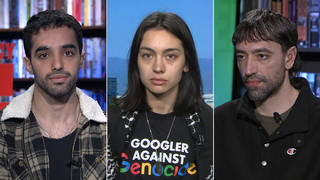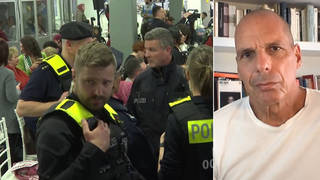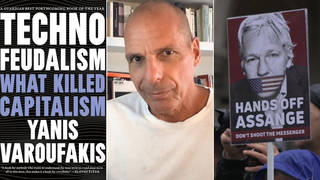
Related
Guests
- Stephen Maingdirector and producer of Crime + Punishment, which has just been shortlisted for an Academy Award for Best Documentary.
- Edwin Raymondlead plaintiff in a lawsuit filed by a group of New York City police officers known as the ”NYPD 12.”
Links
A group of New York Police Department officers are challenging what they call a racially charged policy of quotas for arrests and summonses. Known as the ”NYPD 12,” they risked their reputations and livelihoods to confront their superiors, fight illegal quotas and demand a more just police force. We look at a film following their story called “Crime + Punishment.” It has just been shortlisted for an Academy Award for Best Documentary. We speak with Stephen Maing, the film’s director and producer, and Lieutenant Edwin Raymond, the lead plaintiff in a lawsuit filed by the NYPD 12.
Transcript
JUAN GONZÁLEZ: We turn now to a group of New York Police Department officers, mostly Latino and African-American, who have dared to challenge what they call a racially charged policy of quotas for arrests and summonses. They’re known as the NYPD 12. They risked their reputations and livelihoods to confront their superiors, fight illegal quotas and demand a more just police force. Now they’re being featured in a film called Crime + Punishment. It has just been shortlisted for an Academy Award for Best Documentary. This is the movie’s trailer.
SARAH WALLACE: The department says there are no quotas.
JULIO DIAZ: Well, I can tell you there are quotas in the NYPD.
SIBILA VARGAS: Truly explosive allegations.
CHUCK SCARBOROUGH: They’re coming from police officers who are part of what’s being called the NYPD 12, who filed a class-action lawsuit in federal court.
LT. EDWIN RAYMOND: This is not just another lawsuit—12 cops willing to step up like this—because you’re not going to get this again for a hundred years.
UNIDENTIFIED OFFICER: Hold it for one quick second. Now, to record.
RITCHIE BAEZ: From the beginning I saw how this job was. It was not about helping people; it was about numbers.
UNIDENTIFIED OFFICER: Who’s targeted the most? The minority community.
UNIDENTIFIED OFFICER: Move! Move!
UNIDENTIFIED: And all this got dismissed?
UNIDENTIFIED: All this, got dismissed.
UNIDENTIFIED: Once you start getting arrested, it goes in your record. They’re taking away jobs, that they could be future lawyers, future cops.
UNIDENTIFIED: Supervisors are using police officers as a revenue-producing agent for the city.
LT. EDWIN RAYMOND: This system has to change.
FELICIA WHITELY: We all put our jobs on the line. We put everything on the line.
DERICK WALLER: This is something that was placed on my desk.
UNIDENTIFIED: You’re still a police officer. And there are people in our community that don’t work with police officers, period.
UNIDENTIFIED OFFICER: This is David versus Goliath. Without public support, we’re nothing.
UNIDENTIFIED: How long do you think you’re going to keep the powder keg cap on?
UNIDENTIFIED OFFICER: I believe in struggle. And with struggle comes change.
UNIDENTIFIED: Here in the NYPD, be what cops are supposed to be.
AMY GOODMAN: That was the trailer for the Hulu documentary Crime + Punishment.
For more, we’re joined by the film’s director and producer, Stephen Maing, and the star of the film, Lieutenant Edwin Raymond. Lieutenant Raymond is the lead plaintiff in a lawsuit filed by a group of New York City police officers known as the NYPD 12. But today Lieutenant Raymond is speaking only in the capacity of a private citizen, not on behalf of the NYPD.
We welcome you both Democracy Now! Talk about the significance of this film and why you made it, Steve.
STEPHEN MAING: Sure. Well, first off, thank you so much for having us.
AMY GOODMAN: And congratulations on being shortlisted for the Oscars.
STEPHEN MAING: Thank you. So, my producing partner and I—Ross Tuttle—have been working on this beat for almost seven years now. And what we had seen in our prior work—this is actually our fourth, possibly fifth, project on policing in New York City—was that there was a real disconnect between the messaging that was being put out by the city and the department, and also especially in light of the results from the federal hearing on stop-and-frisk, and what was still persisting on the ground in New York City. And so, because of our prior work and relationships we had in place with some very instrumental officers, like Adhyl Polanco, Pedro Serrano, who were involved in the Floyd v. City of New York hearing, we set out to make an observational documentary that would actually track both the policy as it was playing out within the precincts as well as the impact on the streets.
JUAN GONZÁLEZ: Well, this issue of the quota system in the police department has been actually a long, decades-long, battle. I recall, as a columnist at the Daily News, in 1990 writing a series of articles about—then, it was actually written quotas that the commanding officers would put in the precincts—25 parking summonses, two moving violations and two arrests per month required. And that sparked, eventually, a Mollen Commission, the successor to the Knapp Commission, that also looked at problems within the police department. What has changed to move this issue forward over the last decade since you got involved?
STEPHEN MAING: That’s absolutely correct. And I would say the thing that’s changed, that is actually alarming, is that the problem has been acknowledged, and yet the remedies have not been sufficient. And so, what we set out to do in the film was demonstrate firsthand, by bearing witness to a group—a growing group—of officers, active-duty, that they themselves believe that the mission of policing was still misguided, that could be not just sharpened, but improved, so that not only individuals in heavily targeted minority neighborhoods, but also officers themselves, rank-and-file, could feel more able to do the job that they joined the force to do.
AMY GOODMAN: Stephen Maing, you recently sparred with New York Mayor Bill de Blasio on the NPR station here in New York, WNYC. The mayor insisted there’s no quota system. Let’s go to that part of the exchange.
STEPHEN MAING: There is still a de facto quota in practice. And I was wondering if the mayor had any interest in seeing the film and meeting with the NYPD 12.
MAYOR BILL DE BLASIO: Happily would have senior members of my team meet with him and see the film and address whatever facts are presented. I never want to look away from anyone who’s presenting some information that could be valuable.
But his facts, on the surface, don’t make sense. Arrests are down 37 percent over five years. I gave you the exact comparison of 2017 to 2013: a hundred thousand fewer arrests. The entire training—every officer, 36,000, have been retrained. This is—this is not accidental stuff or small stuff. This is a massive sea change.
AMY GOODMAN: “Massive sea change.”
STEPHEN MAING: Yeah. You know, thank goodness for the mute button—right?—on live radio. I wasn’t able to really interject or follow up.
But, you know, what the mayor was failing to acknowledge was that training is not what actually remedies a situation. You know, we’ve seen the city and the department go through racial sensitivity training, implicit bias training. There have been numerous class-action lawsuits, on the order of tens of millions, hundreds of millions of dollars that pay annually for police misconduct on racial claims. And so, there’s no evidence of an internal restructuring.
But what I can say is to the data is that the NYPD themselves actually released their own racial data on criminal summonsing in the last two quarters of 2017, that demonstrated, when you add up some of the highest earners that cut across racial lines—so, marijuana possession, open container, that blacks and Latinos and whites all use equally—the department has been still targeting these minority communities 5.6 times more often than whites. And that’s in their own data you can find online right now.
JUAN GONZÁLEZ: Lieutenant Edwin Raymond, I wanted to ask you—during the Giuliani years, Commissioner Bratton, during his first tenure here, introduced the CompStat system to basically rule by statistics over—develop policy, crime-fighting policy, by the statistics of where the crimes were being committed. I’m wondering, this emphasis on stats in the police department, how big is it, during the time that you’ve been in the police department, this emphasis on statistics?
LT. EDWIN RAYMOND: OK, again, as Steve said, thanks for having us. So, yeah, you’re right. In the '90s, this is when CompStat, you know, enters the police department, these corporate America types of metrics used in the tax-funded service. And the issue with that is, in corporate America, we're chasing quarterly dividends, whereas in the tax-funded service, you know, it doesn’t always translate so well. And I think that’s where a lot of the problems stem, not understanding that everything—you know, there are certain complexities in policing that just you cannot—it doesn’t fit the metrics used to gauge success.
Now, CompStat has its importance. It shows where there are problematic areas and where—what areas need attention. But it’s what you do after you realize there’s a problem. And unfortunately, because of the concept of broken windows policing, which says we have to overpolice innocuous infractions in order to stop bigger things from happening, this is where the quota is born. You know, it says, so, because of this homicide on this corner, we have to show increased enforcement activity on that corner, and to make sure officers are increasing the activity, you give them a quota. The problem is, there’s a serious human cost to that. And there’s no empirical data that shows any correlation between that type of policing and crime actually dropping.
AMY GOODMAN: Lieutenant, you have said law enforcement uses black bodies to generate revenue.
LT. EDWIN RAYMOND: Yes, yes, because, again, as Steve said, the main things that are enforced in the New York City Police Department, in New York City, in the five boroughs, are things that happen ubiquitously throughout the city, and yet, again, 5.6 times it’s people of color who are being targeted, who are being—who actually have to face the repercussions for committing those violations—marijuana, public consumption of alcohol, amongst other things. So, now, if we simply enforced equally, that would be—you know, I wouldn’t be able to make that statement. But because, again, these things, from my own observation, are happening—honestly, from my observation, it actually happens a little higher in white communities, and yet it’s very rarely are white folks the ones who are getting the summonses and arrests.
AMY GOODMAN: We’re going to go to a break and then come back to this discussion. We’re talking about the documentary Crime + Punishment, just shortlisted for an Oscar. Stay with us.
[break]
AMY GOODMAN: “Welcome to the Struggle” by the First Nations hip-hop group Mob Bounce. This is Democracy Now! We’re talking about the documentary Crime + Punishment. I’m Amy Goodman, with Juan González.
Our guest Lieutenant Edwin Raymond is the lead plaintiff in a lawsuit filed by a group of New York police officers known as the NYPD 12. They say officers are forced to meet monthly quotas for arrests and summonses, despite a 2010 statewide ban on such quotas.
We’re going to turn right now to a clip of the documentary. Lieutenant Raymond made a hidden audio recording of his conversation with his immediate supervisor, Martin Campbell. This clip starts with Raymond.
LT. EDWIN RAYMOND: What’s the issue with me? Just activity? The quota?
SGT. MARTIN CAMPBELL: Due to what your enforcement is, that’s what it is.
LT. EDWIN RAYMOND: But it has to be more, because, technically, when it comes to the numbers—
SGT. MARTIN CAMPBELL: No, no, no. It’s not more. That’s it.
LT. EDWIN RAYMOND: But when it comes to numbers, I’m not the lowest. Even though we’re not supposed to care about numbers, I’m still not the lowest. So why all this extra effort with me?
SGT. MARTIN CAMPBELL: You really want me to tell you what I think it is? You really want me to tell you what I think it is?
LT. EDWIN RAYMOND: Of course, because I need to understand this.
SGT. MARTIN CAMPBELL: You’re a young black man with dreads, very smart, have a loud—have a–what do you call it? A loud say. Meaning your words is loud.
LT. EDWIN RAYMOND: OK.
SGT. MARTIN CAMPBELL: You understand what I’m saying by that?
LT. EDWIN RAYMOND: Yeah.
SGT. MARTIN CAMPBELL: “[bleep] this dude.” Those were their exact words: “[bleep] this dude.”
AMY GOODMAN: So, that clip is a secret audio recording. Lieutenant Raymond, explain what we’re listening to. He’s talking to you as a young black man with dreads.
LT. EDWIN RAYMOND: Yeah. So, one of the things, unfortunately, that my supervisor at the time was forced to do, illegally, was to lower my evaluations, in a way to destroy my career for not complying to this quota system. And so, we’re discussing the low evaluation, you know, extremely below-average evaluation, and he’s basically explaining that this is not his doing, it’s marching orders from above, and the reason why this is happening to me. You know, on top of not meeting the quota, I’m also, you know, a young black man with dreadlocks, and that’s just frowned upon, I mean, I saw, in the police department.
AMY GOODMAN: Why did you go into policing? What was your interaction with the police in East Flatbush when you were growing up?
LT. EDWIN RAYMOND: It wasn’t—as a little kid, it was fine. But then, once I entered about 15, 16, teenage years, it started to change. Officers were throwing me against the wall, going through my pockets illegally. And I started getting that treatment that young black men know very well in New York City. And it was easy for me, at 15 and 16, to say, “Well, he’s a white guy. I’m a black young man. He’s just racist.” You know, that’s how my mind made sense of that interaction. And then it started happening with officers of color, same exact treatment.
So that’s part of the reason why I decided to join policing, to see why—how could, you know, a Puerto Rican, Dominican or non-Hispanic black person treat me the same way. I can’t just write it off as racism and bigotry. And that’s when I went into the police department and learned about the quota system. And I started replaying a lot of the situations that I endured as a teenager, and my friends, and I said, “Wow! OK, now I realize what was really going on the entire time: They were simply trying to meet their quotas.”
JUAN GONZÁLEZ: And, Steve Maing, I’d like to ask you—you’ve been looking at this problem now for years, of policing in not—in New York City, but all major cities. Why do you think that the police departments resist change so systematically? Because when you look at it, the composition of the police force has changed. It used to be all white; now it’s increasingly minority. It’s still a large—disproportionately white, but not nearly as much as it was 30 or 40 years ago. There have been all of these attempts to retrain, reduce arrests, and yet there’s still something in the—it seems to me, in the structure of what the police force has to do that makes it resistant to being able to change.
STEPHEN MAING: Yeah. You know, I think the idea of structural bias in these very large institutions is that it’s very hard to pinpoint. There are no easily trackable, decisive moments—right?—of discriminatory policy at times even. It may not even be written in plain words, not like, you know—or visible, like the civil rights era, you know. But what we’re seeing is that it plays out in innocuous and benign ways through the chain of command, as you hear in some of the recordings that Edwin Raymond shared in the film, such that it’s hard to track and prove, but it is happening nonetheless, when you compile and look holistically at the experience of officers and individuals on the receiving end.
And, you know, additionally, when you ask why is it—why is this department resistant to change, well, there’s a cash value to summonsing. Simple as that. And it is very high, in the tens and hundreds of millions of dollars. Our hope is that—
JUAN GONZÁLEZ: There’s a cash value to arrests, because I had a—I have a cousin who was a police detective for many years—she’s retired now—and she used to tell me that whenever she was going to do an arrest, she always tended to do it toward the end of the shift, because then she would have to go to Central Booking and get OT. So she always had a pillow, and so she could spend eight hours in Central Booking gaining overtime pay just as a result of the arrest.
STEPHEN MAING: Yeah, absolutely. You know, as recently as December of this past year, there was text messages that were received, or, disclosed, from a lieutenant in a Manhattan precinct talking about the stress of TrafficStat coming up, you know, this sort of CompStat review of arrests and summonsing productivity. And, you know, there is demonstrable evidence that’s showing that the pressure’s still on. We’ve had overwhelming response from officers coming up to us after screenings and to the other plaintiffs in the NYPD 12 class action, saying, “Thank you for doing what we couldn’t.”
AMY GOODMAN: Let’s go to another clip from the documentary Crime + Punishment. In this clip, our guest, filmmaker Steve Maing, speaks with New York police officer Sandy Gonzalez.
STEPHEN MAING: Hey, Sandy, what’s going on?
OFFICER SANDY GONZALEZ: Oh, man, these people. They took me off my sector car and put me on a footpost where nothing is going on. Even if something happens in the area, I’m not allowed to move from there until the end of my tour. It’s like being treated like a child, you know, when you put a child in timeout, for the other cops to learn from my example.
AMY GOODMAN: And in this clip, Sandy Gonzalez is confronted by superiors for the alleged infraction of wearing a winter hat in cold weather.
OFFICER SANDY GONZALEZ: What’s up, Sarge? How you doing?
SERGEANT: What’s going on?
OFFICER SANDY GONZALEZ: Not much.
SERGEANT: All right. Your hat—you’re out of uniform, with the hat.
OFFICER SANDY GONZALEZ: What? With the hat? Why?
SERGEANT: It’s not supposed to—not expected be below 32.
OFFICER SANDY GONZALEZ: Yeah, it was. It was like—
SERGEANT: It should be 37, 38.
OFFICER SANDY GONZALEZ: It was this morning.
SERGEANT: No, for the tour. For the tour, it’s expected to be 38 degrees.
OFFICER SANDY GONZALEZ: Thirty-eight degrees?
SERGEANT: Correct.
OFFICER SANDY GONZALEZ: Oh, so I get a CD for this?
SERGEANT: I’m just saying, you’re out of uniform. Now, I’m going to put you in the book.
AMY GOODMAN: So, Lieutenant Edwin Raymond, talk about what’s happening there. And then talk about what you’re hoping to get out of your lawsuit.
LT. EDWIN RAYMOND: So, in the clips with Sandy, it shows—you know, it basically shows that the way that—it’s basically broken windows on police officers. You know, the same petty, innocuous infractions that get overenforced in the public, when you’re on the radar, now, all of a sudden, petty, innocuous violations of the patrol guide get—you know, you get reprimanded for. And the reason being—you know, different things that can put you on the radar, one of the main ones is not meeting the quotas, so that, in that clip, what you see Sandy going through is broken windows enforcement of New York City NYPD procedures.
What I’m hoping is that the department and the city finally understands and respects what people have been saying, activists, people of color have been saying for decades, because the relationship between the department and certain demographics, it’s similar to like a parent to a child, like “You don’t know what’s best for yourself. I know what’s best for you.” Meanwhile, we’re not children. We’re adults, and we know what we’re experiencing.
And in hindsight is always when they say, “Oh.” You know, like right now, one of the things that the department brags about is how low the stop-and-frisk numbers are. But five years ago, before the case closed, was finished, they—you know, they basically said that the judge would be responsible for 20 years of progress of drop in crime. They said it’s dangerous, what she’s done. And Mayor Bloomberg at the time immediately appealed the case. Now, I can give the current mayor credit for dropping that appeal. But what people miss about the Floyd case, the stop-and-frisk case, is stop-and-frisk was just one of three parts.
AMY GOODMAN: We have 10 seconds.
LT. EDWIN RAYMOND: Yeah. There’s the summonses and the arrests, I wish were included. You know, then maybe our lawsuit wouldn’t be necessary.
AMY GOODMAN: I want to thank you both for being with us, New York Police Lieutenant Edwin Raymond and Stephen Maing, director and producer of the documentary Crime + Punishment.












Media Options